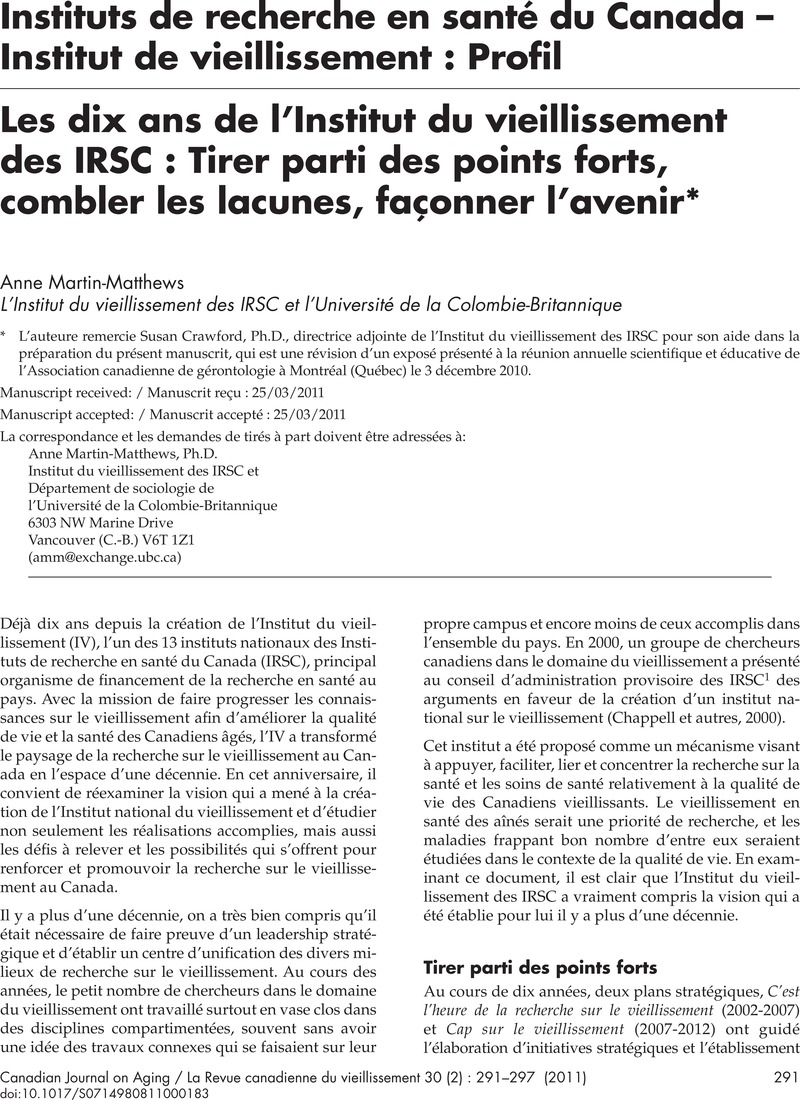No CrossRef data available.
Article contents
Les dix ans de l’Institut du vieillissement des IRSC : Tirer parti des points forts, combler les lacunes, façonner l’avenir*
Published online by Cambridge University Press: 27 June 2011
Abstract
An abstract is not available for this content so a preview has been provided. Please use the Get access link above for information on how to access this content.

- Type
- Canadian Institutes of Health Research–Institute of Aging: Profile/Instituts de recherche en santé du Canada – Institut de vieillissement : Profil
- Information
- Canadian Journal on Aging / La Revue canadienne du vieillissement , Volume 30 , Issue 2 , June 2011 , pp. 291 - 297
- Copyright
- Copyright © Canadian Association on Gerontology 2011
Footnotes
*
L’auteure remercie Susan Crawford, Ph.D., directrice adjointe de l’Institut du vieillissement des IRSC pour son aide dans la préparation du présent manuscrit, qui est une révision d’un exposé présenté à la réunion annuelle scientifique et éducative de l’Association canadienne de gérontologie à Montréal (Québec) le 3 décembre 2010.
References
Références
Abbott, A. (2004). Ageing: Growing old gracefully. Nature, 428, 116–119.CrossRefGoogle ScholarPubMed
Barer, M.L. (2005). Evidence, interests and knowledge translation: Reflections of an unrepentant zombie chaser. Healthcare Quarterly, 8(1), 46–53.CrossRefGoogle ScholarPubMed
Barzilai, N., et Gabriely, I. (2010). Genetic studies reveal the role of the endocrine and metabolic systems in aging. Journal of Clinical Endocrinology and Metabolism, 95(10), 4493–4500.CrossRefGoogle ScholarPubMed
Benady, S. (2011). Living like a centenarian: New drugs may one day help those of us who aren’t genetically blessed to remain healthier into our old age. Maclean’s, 124(10), 42–43.Google Scholar
Binstock, R.H. (2010). From compassionate ageism to intergenerational conflict? The Gerontologist, 50(5), 574–585.CrossRefGoogle ScholarPubMed
Butler-Jones, D. (2010). Le Rapport de l’administrateur en chef de la santé publique sur l’état de la santé publique au Canada, 2010 Vieillir – Ajouter de la vie aux années. Ottawa, Ontario, Canada: ASPC. Extrait le 21 mars 2010 dehttp://www.phac-aspc.gc.ca/cphorsphc-respcacsp/index-fra.php.Google Scholar
Chappell, N., Joanette, Y., McDonald, L., Neysmith, S., Rockwood, K., Stones, M., et autres (2000). Canadian Institutes of Health Research: The Canadian Institute on Aging/Institut du vieillissement. Concept of Operations. Canadian Health Services Research Foundation and Social Sciences and Humanities Research Council of Canada. Extrait le 18 mars dehttp://www.fcrss.ca/publicationsandresources/researchreports/commissionedresearch/99-07-01/98f1d2ac-b730-4000-bca0-3b5b40245da3.aspxGoogle Scholar
Collerton, J., Barrass, K., Bond, J., Eccles, M., Jagger, C., James, O., et autres (2007). The Newcastle 85+ study: Biological, clinical and psychosocial factors associated with healthy ageing: Study protocol. BMC Geriatrics, 7, 14.CrossRefGoogle ScholarPubMed
Fondation canadienne pour l’innovation (janvier 2009). Expert Committee Report, New Initiatives Fund 2009. The Canadian Longitudinal Study on Aging: Understanding the complexity of aging health through interdisciplinary research, Project number: 19909.Google Scholar
Gatehouse, J. (2010). What the boomers are leaving their children: Fewer jobs. Lower pay. Higher taxes. Now the Screwed Generation is starting to push back. Maclean’s, 123 (47), 54.Google Scholar
Havens, B. (1980). Differentiation of unmet needs using analysis by age/sex cohorts. Dans Marshall, V.W. (Ed.), Aging in Canada: Social Perspectives (pp. 215–221). Toronto, Ontario, Canada: Fitzhenry and Whiteside.Google Scholar
Instituts de recherche en santé du Canada (IRSC) (2010a). Endiguer le raz‑de‑marée: Stratégie canadienne pour un leadership international dans la prévention et le traitement précoce de la maladie d’Alzheimer et des démences apparentées – Résumé. Ottawa, Ontario, Canada: IRCC. Extrait le 18 mars 2010 dehttp://www.cihr-irsc.gc.ca/e/documents/icrsad_report_full_2010-03-25_f.pdf.Google Scholar
Instituts de recherche en santé du Canada (IRSC) (2010b). Santé: Célébrons 10 années de succès en recherche. Ottawa, Ontario, Canada: IRSC.Google Scholar
Jackson, R., et Howe, N.. (2008). The Graying of the Great Powers: Demography and Geopolitics in the 21st Century. Washington, DC: Center for Strategic & International Studies.Google Scholar
Kirkwood, T. (2010). Why can’t we live forever? Scientific American, 303(3), 42–49.CrossRefGoogle ScholarPubMed
KT-Equal (2010). The Science of Age-Supportive Built Environments: Canadian Institute of Aging Study Tour to the UK. Extrait le 21 mars dehttp://www.sparc.ac.uk/media/downloads/executivesummaries/age_supportive_environments_monograph.pdfGoogle Scholar
Marlett, N., et Emes, C. (2010). Grey Matters: A Guide for Collaborative Research with Seniors. Calgary, Alberta, Canada: University of Calgary Press.Google Scholar
Marshall, V.W., et Tindale, J.A. (1978–1979). Notes for a Radical Gerontology. International Journal of Aging and Human Development, 9(2), 163–175.CrossRefGoogle ScholarPubMed
Martin-Matthews, A., et Mealing, L. (2009). Editorial: Realizing the vision. The Canadian Longitudinal Study on Aging as a Strategic Initiative of the Canadian Institutes of Health Research. Canadian Journal on Aging, 28(3), 209–214.CrossRefGoogle Scholar
Organisation mondiale de la Santé (1998).Growing Older – Staying Well: Ageing and Physical Activity in Everyday Life. Genève, Suisse: Programme vieillissement et santé et Organisation mondiale de la Santé.Google Scholar
Partridge, L., Bates, G., et Thornton, J. (2011). New science of ageing. Philosophical Transactions of the Royal Society of London. Series B: Biological Sciences, 366(1561).CrossRefGoogle ScholarPubMed
Picard, A. (2010). Stop blaming seniors for soaring health costs. The Globe and Mail, 11 novembre 2010, p. L6.Google Scholar
Tate, R.B., Loewen, B.L., Bayomi, D.J., et Payne, B.J. (2009). The consistency of definitions of successful aging provided by older men: The Manitoba Follow-Up Study. Canadian Journal on Aging, 28(4), 315–322.CrossRefGoogle ScholarPubMed
The Fredericton 80+ Study. Extrait le 22 mars 2010 de http://www.stu.ca/research/80plus/description.htm.Google Scholar


